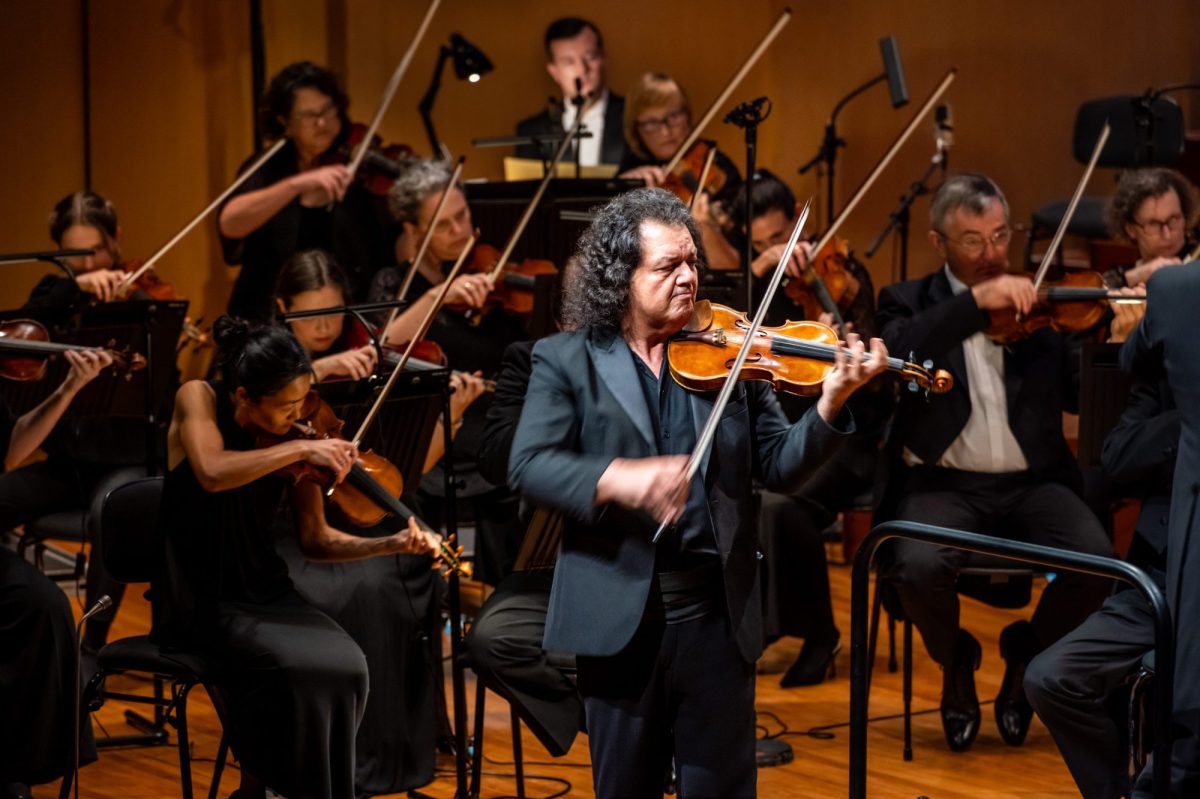Queensland Symphony Orchestra’s (QSO) Symphony Fantastic, subtitled Love, Lust and Madness, was an intriguing introduction to its third Maestro concert for 2024. Three French Romantic composers were chosen to illustrate musical themes ranging from the gruesome through to the hallucinatory and fantastical. The program included Saint-Saёns’ dance of death in Danse Macabre, Ravel’s Romany-influenced violin in Tzigane and the impressive Symphonie Fantastique by Berlioz about unrequited love.
Sufficient humour was introduced to keep the evening light and fun. Alongside some excellent stage lighting, the QSO engaged actor Robert Hofmann, to depict each of the three composers in turn. He introduced his characters and talked about “his” compositions to a script developed by writer/director, Rachel McDonald.
The concert commenced with a harp accompaniment as Hofmann as Saint-Saёns discussed his compositions around the themes of ‘beauty versus truth’. This cued The Dying Swan, played by harpist, Emily Granger and cellist, Umberto Clerici. Both delivered ravishing interpretations, their emotive and delicate playing expressing yearning and deep sadness. ‘Le Cygne’ inspired Hofmann to choose beauty above truth in a nice segue in which he urged the audience to listen to his Danse Macabre.
Swapping his cello and bow for a baton, Chief Conductor Clerici and the QSO then gave us a delightfully frenzied performance of this much loved work. Saint-Saёns recreated a long-held French superstition that Death appears each year at midnight on Halloween, summoning the dead from their graves and encouraging skeletons to dance for him until dawn.
Twelve prophetic strokes from the harp denoted midnight, followed by the violin of “Death”, played by guest Hungarian violinist Jόzsef Lendvay. His strong technique, introducing double notes with their distinct dissonance, created a ghastly sonority well suited to the theme, with his eerily highly-tuned Devil’s chord. The jaunty melody taken up by solo flute and strings centred on a series of descending scales. Orchestral colours burst forth from the darker strings, brass and percussion, and provided a lively image of the frenzied dancing skeletons.
The QSO produced marvellous textural, rhythmic playing accompanying a fierce dynamic contributed by an energetic solo violin. The rattling of bones from the xylophone before a plaintive oboe birdcall reduced the orchestra to pianissimo as dawn broke. The skeletons crept back to their graves with whisper soft notes. Splendid playing and delivery.
As introduced by Hofmann, Ravel’s Tzigane, rapsodie de concert was a less successful characterisation than his earlier Saint-Saёns. The content seemed confusing and the text a little clumsy. Trying to present such a flamboyant character fell somewhat flat.
However, soloist Lendvay came into his own in this gypsy-inspired piece based on Hungarian and Eastern European folk music. He began with a powerful, long cadenza, during which his extraordinary technique was very much on show. With excellent dynamics and first-rate intonation, he gave a virtuosic and passionate performance of considerable dexterity and expert attention to detail.
His ability to play double and even triple stops on his instrument, with ultra-fast bowings on wood as well as on strings, was fascinating to watch. However, Lendvay played a beautifully toned, mellow Stradivarius, the instrument seeming almost too refined for such earthy and raw gypsy-styled music.
The orchestra excelled with strong woodwind, sweeping melodic strings and the gentle strains of a shimmering harp. Clerici kept the whole on track in an understated delivery that allowed Death’s violin to shine and take precedence.
Lendvay offered an encore that was both humorous and technically brilliant – the introduction and theme of Paganini’s Variations on Nel cor più non mi sento. This work showed off his affinity with his instrument, clearly demonstrating that there was nothing he could not do on a violin: bowing and plucking the strings, fingering and hitting the wood, a range of double stops and playing across keys from high to low notes with astonishing speed and accuracy.
Berlioz’ Symphonie Fantastique is the story of an artist’s journey, as Hofmann pointed out in his spoken introduction as the composer. The symphony was written in response to Berlioz’s infatuation with a young actress. A few short sections of the symphony from the first, second and fifth movements were played orchestrally to illustrate some points before the full work was presented.
Hofmann introduced each of the five movements in turn by reading the composer’s program notes. This was certainly helpful in understanding Berlioz’s state of mind – his passion and heartache, his opium addiction and the hallucinatory images of his perceived death with the bizarre final dream. Though one could have wished for a more impassioned vocal delivery from Hofmann to match the heightened music.
The work is a musical roller coaster for players and audience alike, with its range of emotions producing frenzied activity and multiple layers of musical colours within the orchestra. The QSO played with a passion and commitment to this vibrant work that kept the audience on the edge of their seats.
The first movement, ‘Reveries and Passions’, offered contrasting bursts of energy from percussion and brass matched equally by levels of restraint from strings and woodwind. Changes in Berlioz’s tempi helped demonstrate confusion in the artist’s mind. The festive “Ball” of the second movement provided a feisty waltz theme with a powerful melody that rose to a fine crescendo in the strings. Oboe and flute played an excellent solo in unison that was more threatening than joyous, the recurring theme of Berlioz’s infatuation, the ideé fixe brooding over all.
Based on a theme of a pastoral duet between two shepherds, ‘Scene in the Country’ commenced with a haunting cor anglais and a marvellous offstage response from the oboe. The collective work of the woodwind – including flute, piccolo, clarinet and bassoon – was very fine indeed throughout this gentle adagio movement, and concluded with a haunting rumble of thunder in the drums.
The fourth ‘March to the Scaffold’ movement gave us powerful militaristic marching music from pizzicato strings with threatening darker strings, brass and percussion. The tubas and horns were excellent. Denoting the artist’s hallucinatory state as he walks to the gallows, this is music of despair and desperation, that was fiercely and energetically delivered.
The final ‘Dream of a Witches’ Sabbath’ is a descent into hell and Berlioz threw all his orchestra resources at this movement with its ominous death knells, snatches of the Day of Judgement, ‘Dies Irae’, and grotesque music depicting dances with death. Threatening and foreboding, the sonority was loud and dissonant for the most part, though the melody broke through in the woodwinds and led to a forceful and triumphant ending.
Read: Exhibition review: Andrew Fyfe, Joanna Wolthuizen, Lee-Anne Raymond, Demetrios Vakras, SOL Gallery
Clerici conducted this French repertoire with vigour and passion, demonstrating his usual energetic and technically assured style. He was particularly fine in Berlioz’s complex symphony with its many musical layers, bringing out the best performances from his players, especially the excellent work of the woodwind. He is also an accomplished cellist and the opportunity to hear him play during this performance was very well received.
Queensland Symphony Orchestra in association with 4MBS Festival of Classics
presented
Symphony Fantastic
QPAC
Chief Conductor: Umberto Clerici
Soloist: Jozsef Lendvay, violin
Actor: Robert Hofmann
Writer/Director: Rachel McDonald
Symphony Fantastic was performed on 17 and 18 May 2024 and can be heard on ABC Classic on 26 July 2024 at 1pm AEST.





